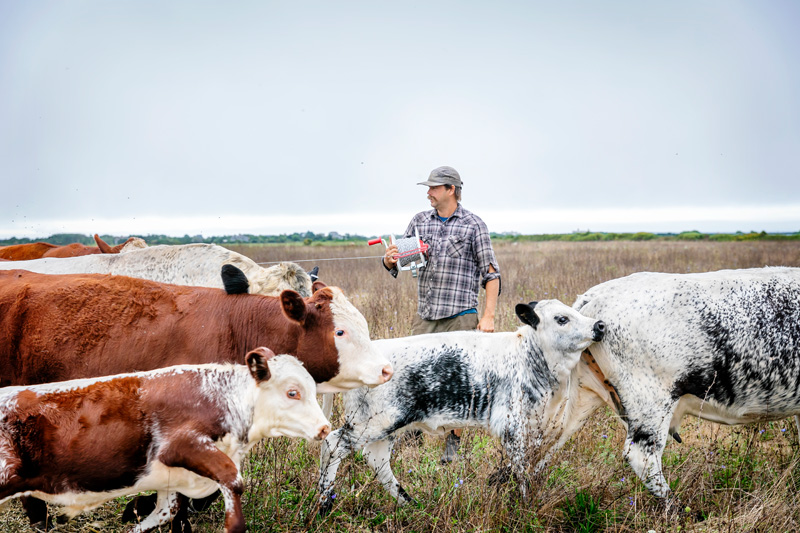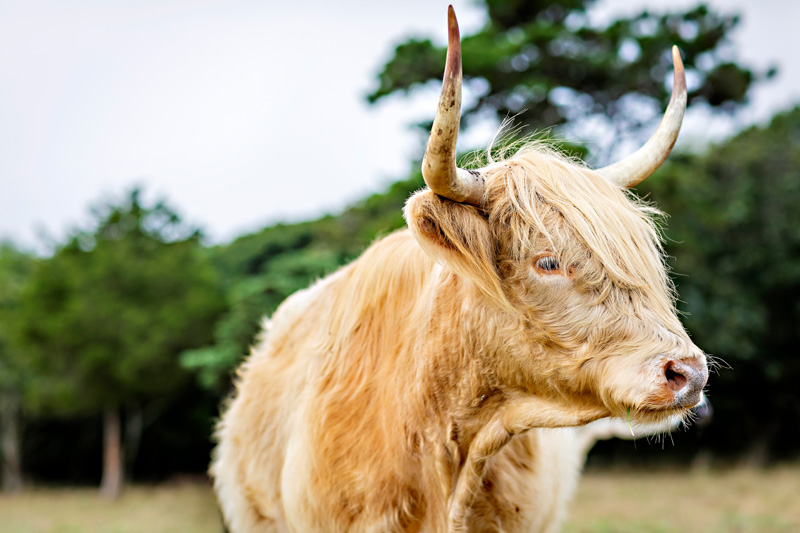
Cows graze on Katama’s sandy, windy pastures, enriching the sandy soil and living a life that’s quite different from that of feedlot animals raised on corn and other grains. A cow’s pregnancy lasts nine months, then it’s another two years or more before the cow is ready for market, because grass-fed cows grow relatively slowly. The meat is sought-after in part because it represents more humane and ecologically conscious farming practices, as well as for its health benefits, with lower fat, higher omega-3s, and increased amounts of some vitamins. Pastured cows contribute to building up plant life, and the grass of fertile pastures captures carbon that offsets the climatic effect of cows’ notorious methane burps. On this Island, where property prices are high, conservation land designated for agriculture helps make beef farming feasible by providing many of the acres of pastures that cows need.
“A large portion of the grazed land here is conservation land,” says Julie Scott of Slough Farm. “We have about 50 acres here owned by the Nature Conservancy. These fields have been hayed and grazed by horses, but now we’re using it to produce food, and restore it,” Julie says. “The whole idea is to have the right number of animals, so when you get to the last pasture, the first one is ready again.” While the cows graze, other creatures make themselves at home. “People are always shocked at how many birds there are in the field,” Julie says. “Ground-nesting birds can be in the same pasture with cows, and in winter when the cows are in the barn, the manure is composted with other things, like food scraps, and spread back onto the pasture.”

Dan Athearn raises beef for Morning Glory Farm at Katama Farm, just around the corner. Edgartown’s Conservation Commission bought the 200 acres of land in 1979, saving it from being subdivided into small lots for seasonal houses. They’ve leased the farm ever since, and Dan’s father, Jim Athearn, worked on the same land when it was farmed by Seaside Dairy in the 1980s. Dan is working to improve the pasture at Katama Farm through a process of intensive grazing. “We pack the cattle on for a few days so they eat or trample all of the stuff you don’t want, but you need some grass just trampled, not grazed,” he says. “My experience has always been more intensive, getting a soil test and then giving it everything it needs, but that’s more of a vegetable-centric approach.” He would like to plow some of the land, but instead he’s using it to pasture hogs, then he’ll till it and plant a cover crop. “We’re trying to promote legumes, like clover and alfalfa, and drought-tolerant grasses. Really I’d be happy with anything, as long as it’s lush. There’s a long way to go on this land.”
Dan’s cows don’t spend all year on pasture because of the lack of grass in winter and the mud in the spring. They spend the colder months in the barn and a small paddock beside it, eating hay. “It’s not uncommon not to have grass in August, because we often have dry Julys,” Dan says. “Last year was a stellar year for grazing — we had seven months of grass last year.” Some, but not all, of the cows’ hay is locally grown — Morning Glory farm grows hay at Quenames in Chilmark and in West Tisbury, while Grey Barn grows hay on some of the 40 acres they lease at Katama Farm.

Cooperation and sharing keep these small farms going, especially when it comes to breeding and building their herds. Julie started working at the FARM Institute at Katama Farm in 2008, years before she started Slough Farm. “There were only three cows there that were producing, that we would breed,” she says. “We slowly built the herd there, and learned a lot from it. All cows are not created equal — you can’t have a cow that’s been raised in confinement or on a lot of grain, and expect them to just be able to graze, and the same is true for the bull. Genetically, there are certain animals and breeds that are able to thrive on grass. You hear a lot about heritage breeds — they’re the heirloom vegetables of the animal world.” Heritage breeds haven’t been bred to thrive in the feedlot environment, and they’re better suited to outdoor living.

“Katama is windy, open, close to the water, and it’s cold in winter,” Julie says. “We find the Scottish breeds — the Scottish Highland, Galloways, and Devons — thrive in the winter, and are more efficient on feed.”
The shaggy brown Scottish Highland cows are less challenged by the cold than many breeds. Then again, when it comes to summer, the hardy cows need shade to keep cool, which is in short supply in Katama. Julie didn’t commit to the Scottish Highland cows until she had gotten shade structures to move around the pastures with the cows. When it came time to get a new bull, though, she decided on another breed, a British White Park. She says that it’s not considered a pure heritage breed, but is somewhere in between the older breeds and modern production animals.
Archie the White Park bull has already visited Nip ’N’ Tuck, Morning Glory, and Blackwater Farms. For Morning Glory Farm, Dan was breeding white-faced Herefords, then he got a Red Devon bull, Moshup, and is now sharing Archie with Slough Farm. This leaves him with a herd that’s a Devon and White Park cross, with a bit of Hereford. The cows gain hybrid vigor from the diversity in their genetic backgrounds, and the system works because not all of the farms breed at the same time of year. “People calve at different times of the year,” Julie says. “We prefer fall calving, but some do spring. It depends on your market and your staffing.”

The Slough Farm animals are ready for processing in the fall, but the meat isn’t available for sale anywhere. Instead, it’s distributed through the Island Grown Initiative’s food equity program. The meat goes to the Food Pantry, the community lunch program, and school cafeterias: “We donate everything we produce. We have founders who fund the operation strictly to benefit the Island. We’re producing the best of the best, and nobody can buy it. We work with the school cooks to figure out what cuts they want, and we want to produce enough to make an impact.” For those who want to buy locally produced beef, there are plenty of other options. (See below.)
“I do think we’re lucky on Martha’s Vineyard,” Julie says. “There are a lot of people that are raising cows, and they’re all being raised in a humane way, even if our practices are different.” Julie manages the barn at the M.V. Agricultural Society’s Agricultural Fair, and says that this year there were more stalls for cows than for any other animal. The amount of beef raised locally is quite small — most grass-fed beef in U.S. markets comes from Australia and South America — but it helps move the Island toward greater food security and more climate-friendly farming practices.


Where’s the beef?
Local beef is available from the following farms, some of which may have limited supplies.
Blackwater Farm 40 Cottle Lane, West Tisbury 774-563-0959 Flat Point Farm (limited supplies) 126 Road to Great Neck, West Tisbury 508-693-4343 Grey Barn and Farm thegreybarnandfarm.com 22 South Road, Chilmark 508-645-4854 Mermaid Farm & Dairy 9 Middle Road, Chilmark 508-939-0140 Morning Glory Farm morninggloryfarm.com 290 West Tisbury Road, Edgartown 508-627-9003 Nip ’n’ Tuck at Ghost Island Farm ghostislandfarm.square.site 27 Davis Look Road, West Tisbury 508-693-5161